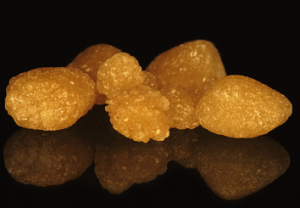Oct 19 2010
Researchers have developed a method for curbing the growth of crystals that form cystine kidney stones.
Their findings, which appear in the latest issue of the journal Science, may offer a pathway to a new method for the prevention of kidney stones.
The study was conducted by researchers at New York University's Department of Chemistry and its Molecular Design Institute, NYU School of Medicine, and the Medical College of Wisconsin.
 Researchers in NYU’s Department of Chemistry and NYU School of Medicine have developed a method for curbing the growth of crystals that form cystine kidney stones.
Researchers in NYU’s Department of Chemistry and NYU School of Medicine have developed a method for curbing the growth of crystals that form cystine kidney stones.
Kidney stones comprised of L-cystine affect at least 20,000 individuals in the United States. This number is substantially smaller than the 10 percent of Americans afflicted by calcium oxalate monohydrate (COM) stones. But L-cystine stones are larger, recur more frequently, and are more likely to cause chronic kidney disease. Current treatments for this disease are somewhat effective, but often lead to adverse side effects.
The formation of L-cystine stones is a consequence of excessive levels of L-cystine in the urine. L-cystine forms into crystals, which aggregate into stones, reaching up to a centimeter in diameter.
Current treatments for L-cystine stone prevention, such as dilution through high fluid intake, can suppress, but may not completely prevent, stone formation. Some medications can react with L-cystine to generate more soluble compounds, but these drugs can cause adverse side effects such as nausea, fever, fatigue, skin allergies, and hypersensitivity.
With the limitations of current treatments in mind, the researchers sought to curb the formation and growth of L-cystine crystals.
Using atomic force microscopy (AFM), which allows for the observation of objects as small as a nanometer, the researchers found that L-cystine crystals grow through the continual attachment of L-cystine molecules to the edges of hexagon-shaped hillocks on the crystal surface. This process results in spiral growth patterns.
Knowing how these crystals grew, the researchers could then select a chemical agent to inhibit this process. Crystal growth can be altered through the use of tailored growth inhibitors. These inhibitors reduce crystallization rates by binding to crystal surfaces in ways that prevent the addition of crystal molecules to the surface, which is necessary for their normal formation.
In the Science study, the researchers used a synthetic agent, L-CDME, which is structurally identical to L-cystine in its center, but is equipped with different molecular "blocking" groups at the ends designed to prevent the attachment of L-cystine molecules to the crystal surface.
Using AFM to observe crystal growth and the effect of this designer inhibitor, the NYU investigators found that L-CDME blocked the growth of the L-cystine crystals by binding to L-cystine molecules protruding from the edges of the hexagon-shaped hillocks. Consequently, the blocking groups obstructed the approach of additional L-cystine molecules to those edges. The researchers found similar success with the introduction of another synthetic agent, L-CME. Their results were confirmed by parallel measurements of crystal yields under the same conditions.
"This may lead to a new approach to preventing cystine stones simply by stopping crystallization," explained Michael Ward, the study's corresponding author and chair of NYU's Department of Chemistry. "Moreover, these findings are an example of the significant advances that can be achieved through collaborations between researchers in physical sciences and in medicine."
Source: http://www.nyu.edu/